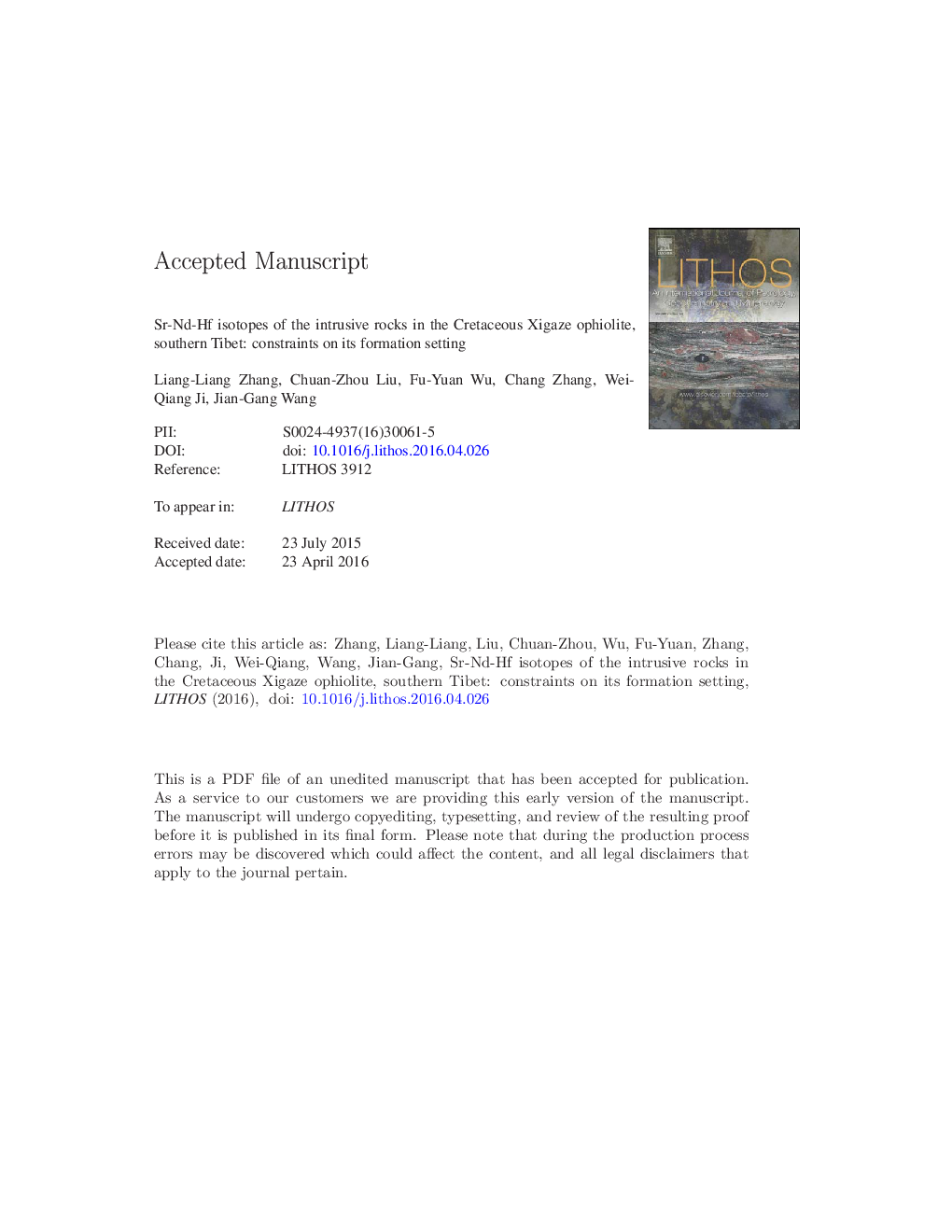| کد مقاله | کد نشریه | سال انتشار | مقاله انگلیسی | نسخه تمام متن |
|---|---|---|---|---|
| 6440436 | 1638645 | 2016 | 53 صفحه PDF | دانلود رایگان |
عنوان انگلیسی مقاله ISI
Sr-Nd-Hf isotopes of the intrusive rocks in the Cretaceous Xigaze ophiolite, southern Tibet: Constraints on its formation setting
دانلود مقاله + سفارش ترجمه
دانلود مقاله ISI انگلیسی
رایگان برای ایرانیان
موضوعات مرتبط
مهندسی و علوم پایه
علوم زمین و سیارات
ژئوشیمی و پترولوژی
پیش نمایش صفحه اول مقاله

چکیده انگلیسی
The Cretaceous Xigaze ophiolite is best exposed at the central part of the Yarlung-Zangbo Suture Zone, Tibet Plateau. It consists of a thick section of mantle peridotites, but a relatively thin mafic sequence. This study presents geochronological and geochemical data for intrusive dykes (both mafic and felsic) and basalts to revisit the formation setting of the Xigaze ophiolite. The rodingites are characterized by high CaO and low Na2O contents relative to mafic dykes and show big variations in trace element compositions. Both gabbros and diabases have similar geochemical compositions, with MgO contents of 6.42-11.48 wt% and Mg# of 0.56-0.71. They display REE patterns similar to N-MORB and are variably enriched in large ion lithophile elements. Basalts have fractionated compositions and display LREE-depleted patterns very similar to N-MORB. They do not show obvious enrichment in LILE and depletion in high-field-strength elements, but a negative Nb anomaly is present. The studied plagiogranites have compositions of trondhjemite to tonalite, with high Na2O and low K2O contents. They have low TiO2 contents less than 1 wt%, consistent with melts formed by anatexis of gabbros rather than by differentiation of basalts. Zircons from seven samples, including three rodingites, three plagiogranites, and one gabbro, have been dated and yielded U-Pb ages of 124.6 ~ 130.5 Ma, indicating the Xigaze ophiolite was formed during the Early Cretaceous. They have mantle-like δ18O values of + 4.92 ~ + 5.26Ⱐand very positive εHf(t) values of + 16 ~ + 13.3. Ages of the rodingites and less altered gabbros indicate that serpentinization was occurred at ~ 125 Ma. Occurrence of both gabbroic and diabase dykes within the serpentinites suggests that the mantle lithosphere of the Xigaze ophiolite was rapidly exhumed. Both mafic and felsic dykes have slightly more radiogenic 87Sr/86Sr ratios relative to MORB, but depleted Hf-Nd isotpe compositions. They have a limited range of εNd(t) values of + 7.9 ~ + 8.9 but variable εHf(t) values ranging from + 9.9 to + 16.7, which are similar to the global MORB. This indicates that the intrusive dykes within the Xigaze ophiolite were derived from a depleted mantle source, which has not been obviously affected by recycling of subducted materials. The MOR-type basalts in this study, combined with the basalts with SSZ signatures previous reported in the literature indicate the diversity of basalts in the Xigaze ophiolite. We apply the forearc hyperextension model to reconcile the occurrence of both MOR- and SSZ-type basalts in the Xigaze ophiolite. In this model, the SSZ-type basalts were produced by melting of the metasomatized mantle wedge during exhumation, whereas the MOR-type basalts were derived from the upwelling asthenosphere triggered by forearc hyperextension.
ناشر
Database: Elsevier - ScienceDirect (ساینس دایرکت)
Journal: Lithos - Volumes 258â259, August 2016, Pages 133-148
Journal: Lithos - Volumes 258â259, August 2016, Pages 133-148
نویسندگان
Liang-Liang Zhang, Chuan-Zhou Liu, Fu-Yuan Wu, Chang Zhang, Wei-Qiang Ji, Jian-Gang Wang,